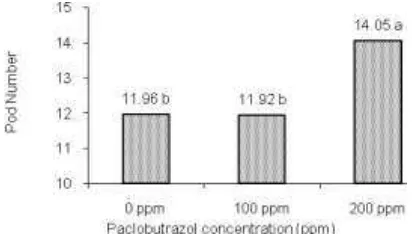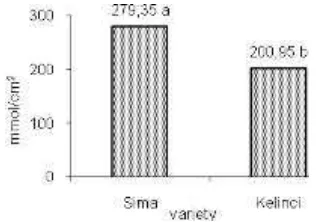Paclobutrazol Application Effectiveness on Growth of Two Peanut
(
Arachis hypogaea
L.) Varieties
Iskandar Lubis
a,*, Aries Kusumawati
b, Munif Ghulamahdi
c, Heni Purnamawati
a, Yudiwanti
WE Kusumo
d, Ahmad Ghozi Mansyuri
e, Sri Astuti Rais
fa
Laboratory of Crop Production, Department of Agronomy and Horticulture, Faculty of Agriculture, Bogor Agricultural University
b
Depatment of Agronomy, Faculty of Agriculture, Andalas University
c Laboratory of Ecophysiology, Department of Agronomy and Horticulture, Faculty of Agriculture, Bogor Agricultural University
d
Laboratory of Plant Breeding, Department of Agronomy and Horticulture, Faculty of Agriculture, Bogor Agricultural University
e
Legume and Tuber Crop Research Center, Indonesian Ministry of Agriculture
f Gen Resource and Biotechnology Research and Development Center, Indonesian Ministry of Agriculture *Corresponding author: Lab of Crop Production, Department of Agronomy and Horticulture,
Faculty of Agriculture, Bogor Agricultural University. Jalan Meranti 1, Kampus IPB Dramaga, Bogor 16680. Indonesia
Tel/Fax: +62-251-8629353. [email protected]
Abstract
Peanuts productivities in Indonesia during 1986–2003 ranged 0.7 to 1.2 ton/ha dry seeds, although some new
varieties having potential yield from 2.0 to 2.5 ton/ha or more, farmers‘ productivity reached only 50–60% of the yield. This research was conducted to investigate the effectiveness of paclobutrazol on the growth and production of peanuts. Experiment was conducted at Bogor Agricultural University farms at Cikabayan. Planting was conducted in April to July 2009, using 2 peanut Varieties, namely Sima and Kelinci. Design of experiment was Split-split plot. Paclobutrazol was applied at 6 and 8 Weeks after Planting, WAP as main plot, Varieties (Sima and Kelinci) was used as sub plot and concentrations of Paclobutrazol (0, 100 and 200 ppm) was used as sub-sub plot with three replicates. Size of experimental unit was (3 x 5) m2, with planting density of 125 000 plants/ha. Urea, SP36 and KCl were applied at planting date at 33.75 kg N, 36 kg P2O5 and 45 kg K2O per ha,
respectively. Observation covered growth and production, such as dry matter production, leaf area index, pod number, pod weight, non-structural carbohydrate and total nitrogen in the stem. The results showed that paclobutrazol concentration at 200 ppm increased pod weight and productivity of peanuts, however, did not affect the total soluble carbohydrate and nitrogen content in the stem at 10 WAP. Sima had vigorous growth than that of Kelinci variety showing bigger leaf area and higher chlorophyll.
Keywords : Peanut, paclobutrazol, growth
Introduction
Peanuts productivities in Indonesia during 1986–2003 ranged from 0.7 to 1.2 ton/ha of dry seeds (Kasno, 2004), although some new varieties having potential yield from 2.0 to 2.5 ton/ha or
Peanut is a semi determinate crop has vegetative growth continuously even if reach the flowering stage. In order to maximize assimilate for filling the pod, it is necessary to investigate source size modification and sink-source balance in peanut. Therefore, retardant as a growth regulator can be used for regulating plant growth balance. Banon et al. (2002) reported that one of growth retardant widely used is paclobutrazol. Moreover, Seeno and Isoda (2003) reported that foliar application of paclobutrazol at 100 and 200 ppm in the stage of initial pod formation and initial and medium pod filling increased seed production of peanuts.
This research aims were to investigate the effect of time application of paclobutrazol on the growth of peanuts; to optimize the paclobutrazol concentration to growth and production of peanuts; and to investigate the growth pattern and production of peanuts.
Materials and Methods
Experiment was conducted at Bogor Agricultural University farm at Cikabayan. Planting was conducted for four months from April to July, 2009. Analysis was done at laboratory of RGCI (Research Group of Crop Improvement), Department of Agronomy and Horticulture, Faculty of Agriculture, Bogor Agricultural University. Materials for experiment were peanut seed of Kelinci and Sima varieties, Urea, SP36 and KCl as fertilizers, KCl was applied at planting date at 33.75 kg; N at 36 kg; P2O5 of 45 kg K2O per ha, respectively. Paclobutrazol was used as retardant.
Design of experiment was Split-split plot design where Time of Paclobutrazol applications (at 6 and 8 Weeks after Planting, WAP) was used as main plot, Varieties (Sima dan Kelinci) was used as sub plot and Dosage of Paclobutrazols (0; 100 and 200 ppm) was as sub-sub plot with three replicates, Size of experimental unit was (3 x 5) m2, with planting density of 125 000 plants/ha. Data were analyzed by F test at 5% level, and advanced test used Duncan Multiple Range Test (DMRT) in 5% level.
Observation included physiological character, growth and production. Growth component covered total dry matter, stem and leaf weight and leaf area index (LAI). Production component covered total number of pod, pod weight and productivity, while physiological character covered chlorophyll, total non-structural carbohydrate (TNC) and stem nitrogen content.
Results and Discussion
The results showed that the single treatment affected the growth of peanut. There was no interaction among time of application, concentration of paclobutrazol and variety. Time of application had significant effect on 8 WAP of peanut. Effect of variety was significant for plant height, total dry matter, culm and leaf dry weight, number of gynophores and pod, 100 seed weight and harvesting index, respectively. Paclobutrazol application had significant effect on plant height, stem dry weight, leaf number, pod number per plant, pod weight per plant, seed weight per plant, seed number per plant and plant productivity, respectively.
Leaf Area Index (LAI)
Figure 1. Leaf Area Index of Peanut varieties. Number followed by similar letter is not significant in 5% level.
Pod Number per Plant
Statistical analysis showed that time application of paclobutrazol and varieties had no significant effect on pod number per plant. There was only the concentration of paclobutrazol having significant effect on the pod number per plant. The highest number of pod represented by 200 ppm paclobutrazol reaching 14 pods per plant, while 0 and 100 ppm produced similar number (12) of pods per plant, respectively, as shown in Figure 2.
Figure 2. Total number of pod per plant after paclobutrazol treatment.
Productivity
Peanut productivity in this experiment represented by pod dry weight per ha. Statistical analysis showed that paclobutrazol concentration significantly affected peanut productivity. The highest productivity performed by 200 ppm paclobutrazol concentration which was 1.18 ton per ha, while concentration 0 and 100 ppm had no significant differences in productivity (Figure 3).
Chlorophyll content
Time of application and paclobutrazol concentrations did not have significant effect on the chlorophyll content. While variety significantly affected the chlorophyll content, and Sima has higher chlorophyll content than Kelinci (Figure 4). Yudiwanti (2007) stated that peanut which has dark green color has higher chlorophyll content and has high yield potential and tolerant to bacterial leaf blight. It is also supported by Taiz and Zeiger (2002) stated that highest content of chlorophyll visually performed by greenness of leaf, and dark green leaf will more efficient to catch solar radiation for photosynthesis.
Figure 4. Chlorophyl content of peanut varietyof Sima and Kelinci.
Total Soluble Carbohydrate and Nitrogen Contents
There was no significant effect of paclobutrazol concentration on the content of total soluble carbohydrate (TNC) and Nitrogen content in the stem at 10 WAP, however, the content of TNC in 200ppm was absolutely higher than that of 0 or 100 ppm of paclobutrazol, and in the opposite nitrogen content in 200 ppm was absolutely lower than that at 0 and 100 ppm paclobutrazol, respectively (Figures 5a and 5b).
The effort for increasing potential yield of peanuts is important role in order to breakthrough barrier from physiological factors. The first step is to assess growth of yield organ, is it limited by availability of source or by sink capacity. Recently, genotype differences in allocation and mobilization pattern of assimilate in the stem of wheat has been sown (Cruz-Aguado et.al. 1999).
( a ) ( b )
Conclusion
Paclobutrazol concentration at 200 ppm increased pod weight and productivity of peanuts, however, it had no significant effect on total soluble carbohydrate and nitrogen content in the stem at 10 WAP. Sima had vigorous growth than that of Kelinci variety showed by bigger leaf area and higher chlorophyll content in the leaf.
References
Arzani, K., H.R. Roosta. 2004. Effect of Paclobutrazol on Vegetatif and Reproductive Growth and Leaf Mineral Content of Mature Apricot (Prunus armeiaca L.) Trees. J.Agri.Sci.Technol. 6:43-55.
Banon, S., A. Gonzales, E.A. Cano, J.A. Franco, J.A Fernandes. 2002. Growth, Developmentand and Colour Response of Potted (Dianthus caryophyllus cv. Mondriaan to Paclobutrazol Treatment. Scientia Horticulturae 94: 371 – 377.
Bell, M.J., G.C. Wright. 1998. Groundnut Growth and development in Contrasting Environment. 1. Growth and Plant Density Responses. Ekperimental Agriculture 34 : 99 – 112.
Cruz-Aguado, J.A., F. Reyes, R. Rodes, I. Perez, M. Dorado. 1999. Effect of Source-to-Sink Ratio on Partitioning of Dry Matter and 14C-photoassimilates in Wheat during Grain Filling. Annals of Botany 83:
655 – 665.
Gardner, F.P., R.B. Pearce, R.L. Mitchell. 1991. Fisiologi Tanaman Budidaya. UI Press. Jakarta. 428 hal. Khasanah, U., H. Purnamawati. 2007. Pertumbuhan dan Produktifitas 5 Varietas Kacang Tanah. [Makalah
Seminar Skripsi]. Departemen Agronomi dan Hortikultura Fakultas Pertanian, Institut Pertanian Bogor. 7 hal.
Kasno, A. 2005. Profil dan Perkembangan Teknik Produksi Kacang Tanah di Indonesia. Seminar Rutin Puslitbang Tanaman Pangan. Bogor. 15 hal.
Lukitas, W. 2005. Uji Daya Hasil Lima Kultivar Kacang Tanah. Skripsi. Departemen Budidaya Pertanian Fakultas Pertanian IPB. 39 hal.
Seeno, S., A. Isoda. 2003. Effect Paclobutrazol on Dry Matter Distirbution and Yield Peanut. Plant Production Science Vol. 6. P90-94.
Taiz, Zeiger. 2002. Plant Physiology (3rd edition). Sinauer Associates, Inc. Massachutes, USA.
Yudiwanti. 2007. Galur Kacang Tanah Berdaun Hijau Tua: Keunggulan dan Pengendalian Genetiknya. Prosiding Seminar Nasional Hasil Penelitian yang dibiayai oleh Hibah Kompetitif; Bogor, 1 – 2 Agustus 2007. Hlm 143 – 146.

